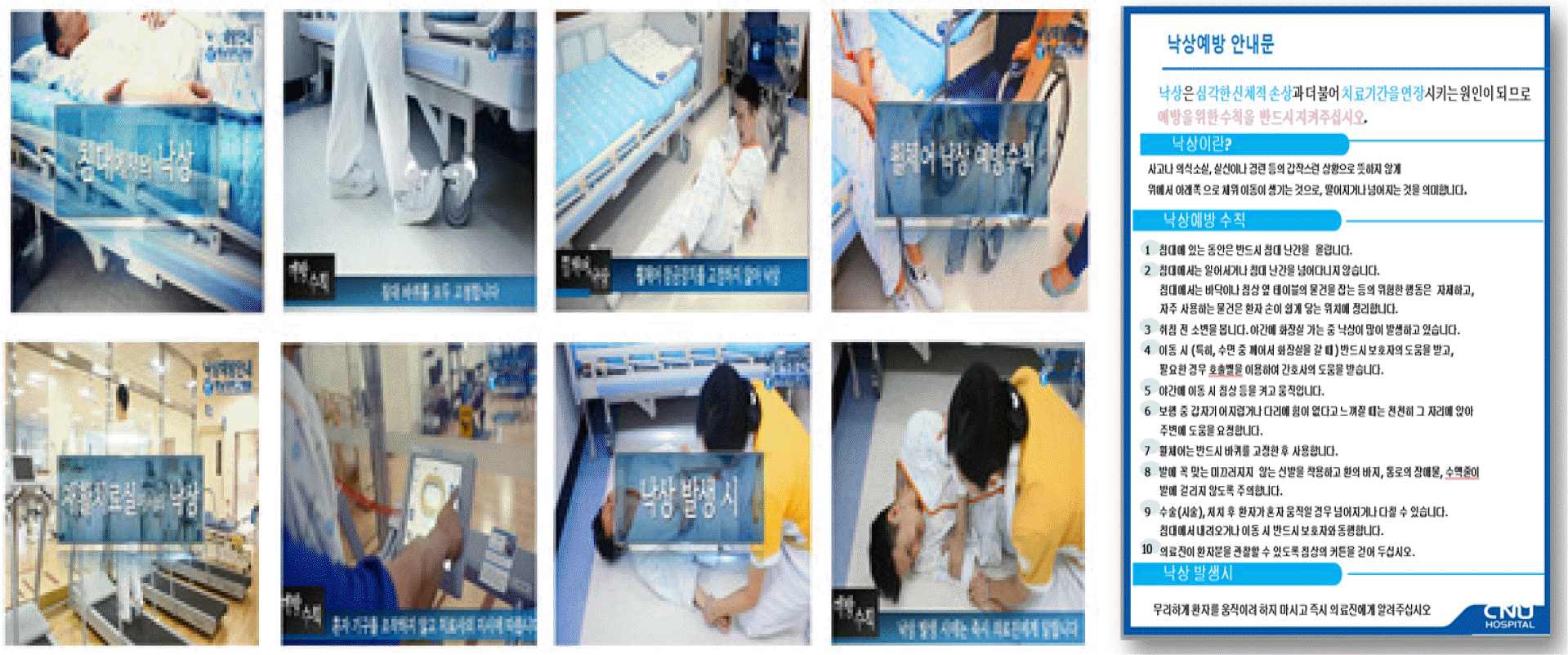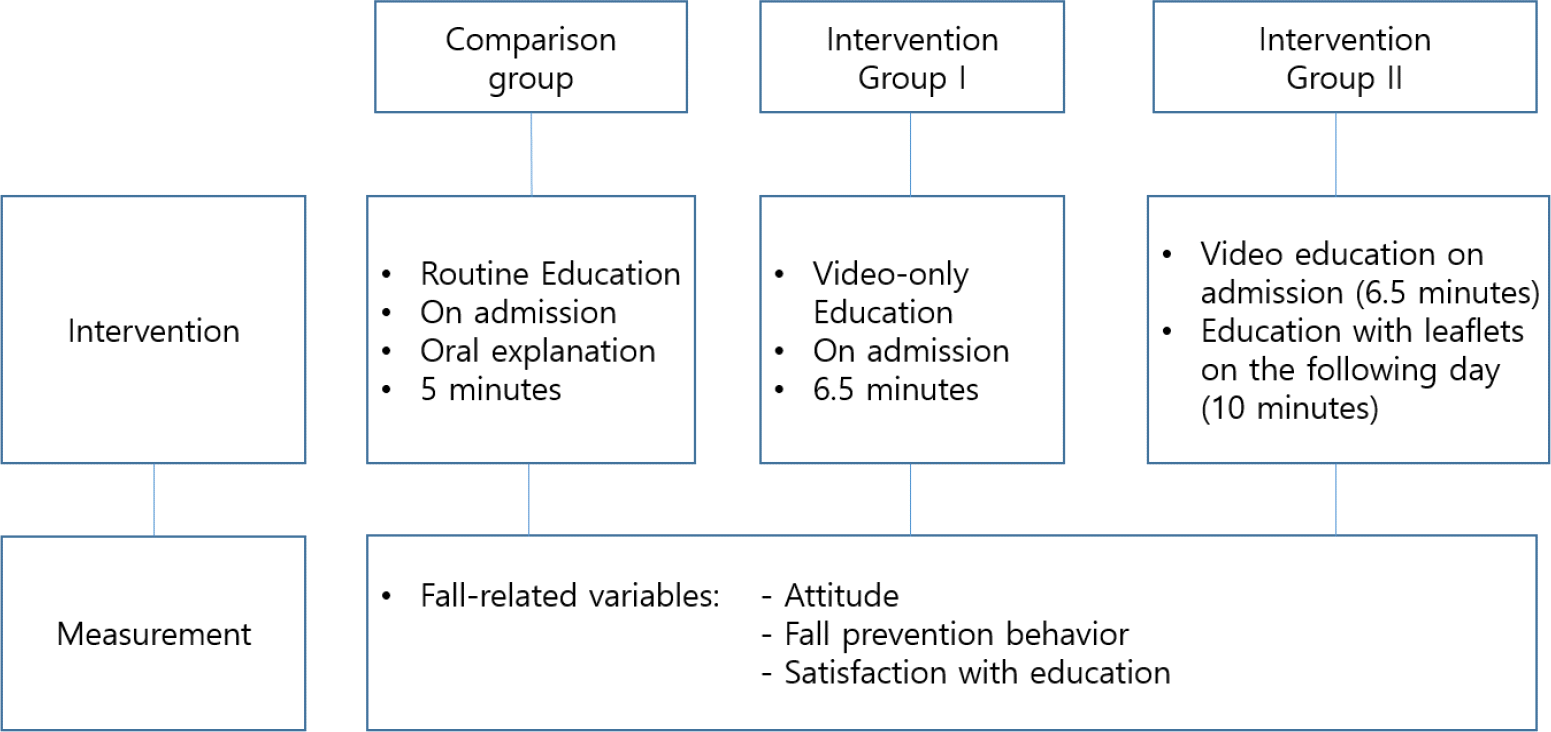Abstract
Purpose
The aim of the study was to examine effects of a fall prevention education program among inpatients over 65 years old.
Methods
A quasi- experimental study with two intervention groups and a comparison was used. One hundred and forty-three participants recruited from one university hospital were assigned to one of three groups: Video-only education (n=49), video plus leaflet education (n=45), and a comparison group who received a routine education (n=49). The data collection period was from March to August 2016.
Results
The two intervention groups reported higher scores in fall prevention behaviors than the comparison group (F=19.83, p<.001). Participants who viewed the video and received the leaflet education reported higher scores than those with video only education. The scores of attitudes toward falls (F=16.05, p<.001), and satisfaction with education (F=40.02, p<.001) in both intervention groups were also significantly higher than the comparison group, with no significant difference between the two intervention groups.
REFERENCES
1.Statistics Korea. 2017 Statistics for elders [Internet]. Seoul: Statistics Korea;2017. [Cited 2017 September 26]. Available from. http://kostat.go.kr/portal/korea/kor_nw/2/1/index.board?bmode=read&aSeq=363362.
2.Statistics Korea. Fall experience by general characteristics of the elderly [Internet]. Seoul: Statistics Korea;2014. [Cited 2016 December 7]. Available from. http://kosis.kr/statHtml/statHtml.do?orgId=117&tblId=DT_117071_2014N041&conn_path=I2.
3.Lee JH., Kim HA., Park SW. Prevention of fall in the hospital. Journal of the Korean Medical Association. 2015. 58(2):123–30. https://doi.org/10.5124/jkma.2015.58.2.123.

4.Miller CA. The connection between drug and falls in elders. Geriatric Nursing. 2002. 23(2):109–10. https://doi.org/10.1067/mgn.2002.123794.
5.Coussement J., Paepe LD., Schwendimann R., Denhaerynck K., Dejaeger E., Milisen K. Interventions for preventing falls in acute-and chronic-care hospitals: a systematic review and meta- analysis. Journal of the American Geriatrics Society. 2008. 56(1):29–36. https://doi.org/10.1111/j.1532-5415.2007.01508.x.
6.Cumming RG., Sherrington C., Lord SR., Simpson JM., Vogler C., Cameron ID, et al. Cluster randomised trial of a targeted mul-tifactorial intervention to prevent falls among older people in hospital. British Medical Journal. 2008. 336(7647):758–60. https://doi.org/10.1136/bmj.39499.546030.BE.

7.Hendrich AL., Bender PS., Nyhuis A. Validation of the Hendrich II fall risk model: a large concurrent case/control study of hospitalized patients. Applied Nursing Research. 2003. 16(1):9- 21.https://doi.org/10.1053/apnr.2003.016009.

8.Kim YS., Chio-Kwon S. Fall risk factors and fall risk assessment of inpatients. Korean Journal of Adult Nursing. 2013. 25(1):74–82. https://doi.org/10.7475/kjan.2013.25.1.74.

9.Bergland A., Wyller TB. Risk factors for serious fall related injury in elderly women living at home. Injury Prevention. 2004. 10(5):308–13. https://doi.org/10.1136/ip.2003.004721.

10.Oliver D., Daly F., Martin FC., McMurdo MET. Risk factors and risk assessment tools for fall in hospital inpatients: a systematic review. Age and Ageing. 2004. 33(2):122–30. https://doi.org/10.1093/ageing/afh017.
11.Kim YJ. Nurses' experience of inpatient's falls. Journal of Korean Academy of Fundamentals of Nursing. 2017. 24(2):106–17. .S. https://doi.org/10.7739/jkafn.2017.24.2.106.

12.Mores JM. Enhancing the safety of hospitalization by reducing patient falls. American Journal of Infection Control. 2002. 30(6):376–80. https://doi.org/10.1067/mic.2002.125808.
13.Kim SR., Yoo SH., Shin YS., Jeon JY., Kim JY., Kang SJ, et al. Comparison of the reliability and validity of fall risk assessment tools in patients with acute neurological disorders. Korean Journal of Adult Nursing. 2013. 25(1):24–32. https://doi.org/10.7475/kjan.2013.25.1.24.

14.Haines TP., Hill KD., Bennell KL., Osbone RH. Patient education to prevent falls in subacute care. Clinical Rehabilitation. 2006. 20(11):970–9. https://doi.org/10.1177/0269215506070694.

15.Hur JY., Kim HJ. Relationship of risk factors, knowledge and attitude to falls in elderly inpatients. Journal of Korean Gerontological Nursing. 2009. 11(1):38–50.
16.Cha KS., Beak SM., Cho OH. Effects of fall prevention education on the variables related to using orthosis and fear of falling in fracture patients wearing the leg orthosis. Journal of Muscle Joint Health. 2012. 19(2):131–41. https://doi.org/10.5953/JMJH.2012.19.2.131.

17.Hyeon IS., Park MH., Park KM., Kim CN. The effects of a fall prevention program on the low-income elderly at risk of falls. Journal of Korean Academy Community Health Nursing. 2010. 21(2):200–9. https://doi.org/10.12799/jkachn.2010.21.2.200.

18.Kim MY. Fall-related knowledge and prevention behavior among hospitalized elderly inpatients [master's thesis]. Daegu: Keimyung University;. 2008.
19.Jeong HC., Seong KM., Jeog MY. The effect of a hospital life guidance movie for elderly in-patients. Journal of Korean Academy of Fundamentals of Nursing. 2010. 17(2):142–8.
20.Kook MJ. A study on the effect and application of motion picture materials in geography subject. The Journal of The Kore-an Association of Geographic and Environmental Education. 2003. 11(3):119–32.
21.Hill AM., McPhai S., Hoffmann T., Hill K., Oliver D., Beer C, et al. A randomized trial comparing digital video disc with written delivery of falls prevention education for older patients in hospital. Journal of the American Geriatrics Society. 2009. 57(8):1458–63. https://doi.org/10.1111/j.1532-5415.2009.02346.x.

22.Chong KJ. Effects of the video-based education for foot care on the self-care behaviors and foot condition of elderly patients with diabetes [master's thesis]. Seoul: The Catholic University of Korea;. 2014.
23.Kang YO., Song RY. Identifying characteristics of fall episodes and fall-related risks of hospitalized patients. Journal of Muscle Joint Health. 2015. 22(3):149–59. https://doi.org/10.5953/JMJH.2015.22.3.149.

24.Lach HW. Incidence and risk factors for developing fear of falling in older adults. Public Health Nursing. 2005. 22(1):45–52. .SS. https://doi.org/10.1111/j.0737-1209.2005.22107.x.

25.Kim YJ., Lee GE. Evaluation of readability of health leaflets and health literacy of elderly inpatients in a medical center. Journal of Korea Gerontological Nursing. 2014. 16(1):9–17. https://doi.org/10.17079/jkgn.2014.16.1.9.
26.Jung KI., Park JS. The effect of audiovisual information with videotape on knowledge, attitude and practice of pap smear of cervical cancer. Journal of Korean Society of Maternal Child Health. 2004. 8(2):211–33.
27.Hwang SY., Shin SJ. Predictors of fall prevention behaviors in elderly inpatients. Korean Journal of Health promotion. 2013. 13(2):76–85.
28.Chung MS. The effects of fall prevention education on the fall-related knowledge and prevention activity of the elderly hospitalized in internal medicine department. Journal of Muscle Joint Health. 2013. 20(2):102–11. https://doi.org/10.5953/JMJH.2013.20.2.102.

29.Kim JH. The effects of a memory training program for adults depression and memory self-efficacy. The Korean Journal of Rehabilitation Nursing. 2002. 5(1):60–70.
Table 1.
Homogeneity Test of General Characteristics among Groups (N=143)
Table 2.
Homogeneity Test of Disease Characteristics among Groups (N=143)
| Variables | Categories | Comparison (n=49) | Intervention I (n=49) | Intervention II (n=45) | x2 | p |
|---|---|---|---|---|---|---|
| n (%) or M± SD | n (%) or M± SD | n (%) or M± SD | ||||
| Past experience of fall | Yes | 18 (36.7) | 17 (34.7) | 10 (22.2) | 2.65 | .266 |
| No | 31 (63.3) | 32 (65.3) | 35 (77.8) | |||
| On IV therapy | Yes | 39 (79.6) | 35 (71.4) | 28 (62.2) | 3.46 | .177 |
| No | 10 (20.4) | 14 (2836) | 17 (37.8) | |||
| Nursing unit | Medicine | 27 (55.1) | 27 (55.1) | 27 (60.0) | 0.30 | .860 |
| Surgery | 22 (44.9) | 22 (44.9) | 18 (40.0) | |||
| Disease† | Hypertension | 30 (62.1) | 26 (53.1) | 29 (64.4) | 1.40 | .507 |
| Diabetes | 14 (28.6) | 12 (24.5) | 15 (33.3) | 0.90 | .638 | |
| Cancer | 14 (28.6) | 14 (28.6) | 16 (35.6) | 0.71 | .703 | |
| Heart disease | 8 (16.3) | 8 (16.3) | 9 (20.0) | 0.29 | .866 | |
| Spinal problem | 8 (16.3) | 4 (8.2) | 7 (15.6) | 1.71 | .425 | |
| Respiratory disease | 6 (12.2) | 2 (4.1) | 4 (8.9) | 2.14 | .335‡ | |
| Osteoporosis | 4 (8.2) | 2 (4.1) | 3 (6.7) | 2.52 | .811‡ | |
| Number of medications taking that affects fall | ≤1 | 32 (65.3) | 38 (77.6) | 26 (57.8) | 5.72 | .217 |
| 2~3 | 14 (28.6) | 8 (16.3) | 17 (37.8) | |||
| ≥4 | 3 (6.1) | 3 (6.1) | 2 (4.4) | |||
| MFS score | No risk | 12 (24.5) | 24 (49.0) | 14 (31.1) | 7.17 | .127 |
| Low risk | 26 (53.1) | 19 (38.8) | 23 (51.1) | |||
| High risk | 11 (22.4) | 6 (12.2) | 8 (17.8) |
Table 3.
Effects of Fall Prevention Education Program on Outcome Variables among Groups (N=143)
| Variables | Comparison (n=49)a | Intervention I (n=49)b | Intervention II (n=45)c | F | p | Scheffé |
|---|---|---|---|---|---|---|
| M± SD | M± SD | M± SD | ||||
| Fall attitude | 2.73±0.59 | 3.11±0.59 | 3.17±0.62 | 16.05† | <.001 | a< b, c |
| Fall prevention behavior | 2.52±0.87 | 2.97±0.09 | 3.30±0.90 | 19.83† | <.001 | a< b< c |
| Satisfaction with education | 3.15±1.12 | 4.46±0.12 | 4.40±0.12 | 40.02† | <.001 | a< b, c |




 PDF
PDF ePub
ePub Citation
Citation Print
Print




 XML Download
XML Download